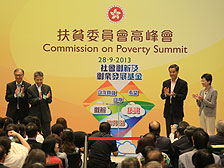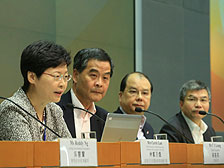
Threshold defined:
Chief Executive CY Leung (second right) opens the first Commission on Poverty Summit, at which Chief Secretary Carrie Lam (first right) announces the poverty line.
Threshold defined:
Chief Executive CY Leung (second right) opens the first Commission on Poverty Summit, at which Chief Secretary Carrie Lam (first right) announces the poverty line.

Meet the media:
Chief Executive CY Leung (second left), Chief Secretary Carrie Lam (first left), and Secretary for Labour & Welfare Matthew Cheung (third left) attend a media session after the summit.
Meet the media:
Chief Executive CY Leung (second left), Chief Secretary Carrie Lam (first left), and Secretary for Labour & Welfare Matthew Cheung (third left) attend a media session after the summit.
Poverty line set for HK
September 28, 2013
Chief Executive CY Leung chaired the first Commission on Poverty Summit today, at which Chief Secretary and commission Chairman Carrie Lam announced the poverty line for 2012 to be 50% of median monthly household income before tax and welfare transfers.
The 2012 poverty line for one-person households is set at $3,600, and at $7,700, $11,500, $14,300, $14,800 for two, three, four and five-person households, and $15,800 for households with six or more people.
Mrs Lam pointed out the poverty line has limitations as an analysis tool.
“For example, assets are not taken into account and this may overstate the number of people living in poverty. Hence, a poverty line should not be taken as the poverty-alleviation line,” she said, adding that relative poverty will mean a poorer population always exists statistically.
Among the 400,000 households below the poverty line after taking recurrent cash benefits into account, 102,700 households were living on Comprehensive Social Security Assistance. The remaining 300,300 were non-CSSA households, of which 11,300 households were unemployed, 143,500 households were working households and 145,500 households were economically inactive households.
Before policy intervention, there were 541,000 poor households, involving 1,312,000 people, and the poverty rate was 19.6%. Mrs Lam said policy intervention can bring down the number of households in poverty to 403,000, involving 1,018,000 people, resulting in a poverty rate of 15.2%.
For all 1.02 million people to be lifted up to the poverty line, $14.8 billion would be needed, she said. This represents an average of $3,100 spent per household.
Mrs Lam said Comprehensive Social Security Assistance has the most notable impact on poverty alleviation among recurrent cash policies, lifting 90,000 households out of poverty.
Among the 100,000 CSSA households who were still living under the poverty line after policy intervention, almost 80% were public housing tenants and 10% were living in self-financed private housing or Home Ownership Scheme flats. It is believed they do not face significant problems with housing needs.
Mrs Lam said the 140,000 non-CSSA working households should be given priority, as this group of households has a greater number of people, more than 80% of which are households of three people or more. That means a dependency ratio of 1:2, or one person supporting three dependents, with 30% being children and students, she said.
Mrs Lam said employment is the best way to tackle poverty. Actions proposed included work incentives, focusing public resources on the working poor, and supporting youth in CSSA families in their studies.
Apart from members of the commission and its six task forces, representatives of political, business and academic sectors, think tanks, non-governmental organisations, service groups, and principal officials took part in today's summit.
At the summit, Mr Leung officiated at ceremonies for projects under three task forces – the inauguration ceremony for the Social Innovation & Entrepreneurship Development Fund, the launching ceremonies for the Future Stars programme and the Talent-Wise Employment Charter and Inclusive Organisations Recognition Scheme.
During the second half of the summit, Mr Leung, Mrs Lam and task force chairpersons and vice-chairpersons exchanged views with participants on poverty-alleviation strategies and work priorities.
At a press conference after the summit, Mr Leung said the Government has been determined to set the poverty line, which has been done for the first time now in Hong Kong.
There are many reasons for poverty he said, including old age, illness and inadequate salary, and giving out cash handouts cannot resolve the problem.
Economic development can help to improve poverty, creating more jobs and helping people achieve self-reliance through alleviation measures.
Mrs Lam said a poverty line does not equate to a poverty prevention line, nor is it an intervention threshold.
She said the Government wants to mobilise and provide people with more opportunities for upward mobility.